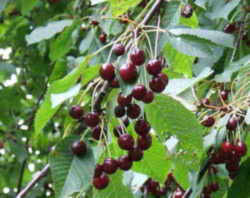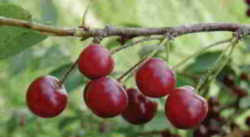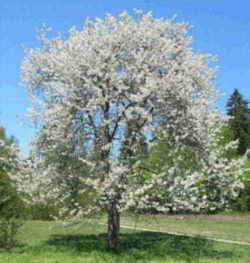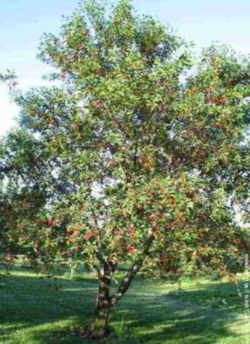
Utah Symbols
Utah State Fruit
Cherry

(Prunus avium & Prunus cerasus)
Adopted on March 5, 1997.
House Bill HB33, which designated the cherry as the official state fruit in 1997, was sponsored by Rep. Fred Hunsanker, R-Logan; the 2nd graders at Millville Elementary School in Millville, Utah were responsible for presenting the new state fruit. Thank you to the school children for researching the subject and gathering the following information.

The Millville Elementary School children selected fruit as their choice to support as a new state symbol and chose the apple, peach, and cherry as candidates. After compiling some basic information concerning each of these fruits and their economic impact upon Utah and polling elementary schools throughout the state, the cherry came out the leader.
Pictured Prunus cerasus (Top Right); Prunus avium (Right)
Utah State Fruit: Cherry
Both sweet and tart or pie cherries are grown in Utah; the average yearly cherry sales for the past 5 years was $5,564.600. Utah is the second largest
tart cherry producing state in the nation and fifth in the nation in the production of sweet cherries. No other state ranks in the top five in both
categories. About 2 billion cherries are harvested yearly and approx. 4,800 acres of agricultural land is used for cherry production. Cherries are
grown in Utah, Box Elder, Weber, Davis, Salt Lake, and Washington counties. The cherries are sold as fresh fruit, to canneries to make pies, brined
as maraschino cherries or dried.
Another interesting fact, submitted to the Millville Elementary School children, is that cherry trees were sent to Utah by the Japanese following World
War II. They surround the capitol building in Salt Lake City. The cherry tree is a symbol of friendship to the Japanese.
Utah's 2002 tart and sweet cherry production's forecast is the lowest since 1972 due to frost early in the growing season. Utah expects a tart cherry crop of 3.0 million pounds, 75 percent smaller than last season. Sweet cherry production is forecast at 400 tons, a decline of 43 percent from last year's crop, and the second lowest level since estimates began in 1938. About 4,800 acres of Utah land is devoted to cherry production, primarily in Utah, Box Elder, Weber, Davis, Salt Lake, and Washington counties. Utah cherries are sold as fresh fruit, to canneries to make pies, brined as maraschino cherries or dried.
Characteristics of Cherries
The cherry is the juicy fruit of many plants of the genus Prunus, and is a fleshy drupe (stone fruit). The cherry fruits of commerce are usually obtained from a limited number of species such as cultivars of the sweet cherry, Prunus avium. The name 'cherry' also refers to the cherry tree, and is sometimes applied to almonds and visually similar flowering trees in the genus Prunus, as in "ornamental cherry", "cherry blossom", etc. Wild Cherry may refer to any of the cherry species growing outside of cultivation, although Prunus avium is often referred to specifically by the name "wild cherry" in the British Isles.
Prunus cerasus (sour cherry, tart cherry or wild cherry) is a species of Prunus in the subgenus Cerasus (cherries). Prunus avium, commonly called wild cherry, sweet cherry, bird cherry, or gean
The tree is smaller than the sweet cherry (growing to a height of 4-10 m), has twiggy branches, and its crimson-to-near-black cherries are borne upon shorter stalks
Sweet cherry Rosaceae Prunus avium

Leaf: Alternate, simple, 2 to 5 inches long, oval to obovate, serrated margin (slightly rounded teeth), obvious darkened glands on petiole, generally with more than 8 pairs of veins.
Flower: Showy, white, 1 inch across, 3 to 5 per cluster, appearing early spring.
Fruit: Sweet, dark red to nearly black drupe, 1/2 to 1 inch across, may be clustered on spur shoots; matures early to mid summer.
Twig: Medium textured, gray-brown, with a mild bitter almond taste; buds large (up to 1/4 inch), reddish brown; spur shoots present with multiple terminal buds.
Bark: Gray-brown, smooth, with prominant, long horizontal lenticels, often peels.
Form: A small to medium sized tree, generally to 50 feet, with a broadly rounded crown
Sour cherry Rosaceae Prunus cerasus L.

Leaf: Alternate, 2 to 5 inches long, oval to obovate, serrate margins, obvious darkened glands on petiole, generally with less than 8 pairs of veins.
Flower: White, 5 petals, 3 to 5 per cluster, appearing in mid-spring.
Fruit: Sweet, dark red to black, 1/2 to 1 inch across, may be clustered on spur shoots; matures early to mid summer.
Twig: Medium textured, gray-brown, buds reddish brown, spur shoots present (spurs with multiple terminal buds), with a mild bitter almond taste.
Bark: Red to gray-brown, tight but somewhat rough, with prominant horizontal lenticels, often peels.
Form: A small tree, generally to 30 feet, with a broadly rounded crown.
Utah Code
The law designating the cherry as the official Utah state fruit is found in the Utah Statutes, Title 63, Chapter 13, Section 63-13-5.5.
TITLE 63. State Affairs in General.
CHAPTER 13. Miscellaneous Provisions.
SECTION 63-13-5.5. State Symbols.
63-13-5.5. State symbols.
(1) Utah's state animal is the elk.
(2) Utah's state bird is the sea gull.
(3) Utah's state centennial astronomical symbol is the Beehive Cluster located in the constellation of Cancer the Crab.
(4) Utah's state centennial star is Dubhe, one of the seven bright stars composing the Big Dipper in the constellation Ursa Major.
(5) Utah's state centennial tartan, which honors the first Scots known to have been in Utah and those Utahns of Scottish heritage, shall have a pattern
or repeating-half-sett of white-2, blue-6, red-6, blue-4, red-6, green-18, red-6, and white-4 to represent the tartan worn anciently by the Logan and
Skene clans, with the addition of a white stripe.
(6) Utah's state cooking pot is the dutch oven.
(7) Utah's state emblem is the beehive.
(8) Utah's state fish is the Bonneville cutthroat trout.
(9) Utah's state flower is the sego lily.
(10) Utah's state folk dance is the square dance, the folk dance that is called, cued, or prompted to the dancers and includes squares, rounds, clogging,
contra, line, and heritage dances.
(11) Utah's state fossil is the Allosaurus.
(12) Utah's state fruit is the cherry.
(13) Utah's state vegetable is the Spanish sweet onion.
(14) Utah's historic state vegetable is the sugar beet.
(15) Utah's state gem is topaz, as is prominently found in the Thomas Mountain Range in Juab County, Utah.
(16) Utah's state grass is Indian rice grass.
(17) Utah's state hymn is "Utah We Love Thee" by Evan Stephens.
(18) Utah's state insect is the honeybee.
(19) Utah's state mineral is copper.
(20) Utah's state motto is "Industry."
(21) Utah's state railroad museum is Ogden Union Station.
(22) Utah's state rock is coal.
(23) Utah's state song is "Utah This is the Place" by Sam and Gary Francis.
(24) Utah's state tree is the blue spruce.
Taxonomic Hierarchy: Cherry
Kingdom: Plantae - Plants
Subkingdom: Tracheobionta - Vascular plants
Superdivision: Spermatophyta - Seed plants
Division: Magnoliophyta - Flowering plants
Class: Magnoliopsida - Dicotyledons
Subclass: Rosidae
Order: Rosales
Family: Rosaceae - Rose family
Genus: Prunus L. - plum
Species: Prunus cerasus L. - sour cherry
Species: Prunus avium (L.) L. - sweet cherry

List Official US State Foods






